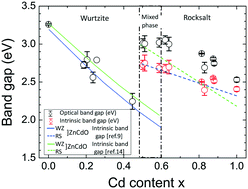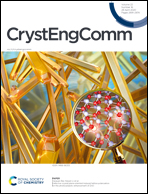Realization of rocksalt Zn1−xCdxO thin films with an optical band gap above 3.0 eV by molecular beam epitaxy
Abstract
We have grown Zn1−xCdxO (ZnCdO) thin films by molecular beam epitaxy on α-Al2O3 (0001) substrates across the full composition range of 0 ≤ x ≤ 1. The wurtzite phase is observed in the composition x ≤ 0.44 whereas the rocksalt phase is observed for x ≥ 0.58. Within the composition region of 0.44 < x < 0.58, both wurtzite and rocksalt phases co-exist. At the phase transition to RS at x ∼ 0.55, the optical gap increases drastically to >3.0 eV. A large optical gap of 3.0 eV (an intrinsic gap of ∼2.7 eV) is achieved for RS-ZnCdO alloys at x ∼ 0.6. The stability of the RS phase with a low Cd content can be attributed to the low temperature MBE process. The upward shift of the band gap energy is observed in the mixed phase region due to the phase transition, and the largest band gap energy is obtained as 3.27 eV in the WZ (x = 0) and 3.0 eV in RS (x = 0.6) phase. RS-ZnCdO thin films exhibit a low resistivity of 5 × 10−4 Ω cm with a maximum mobility of ∼90 cm2 V−1 s−1 and a high carrier concentration of 4 × 1020 cm−3.



 Please wait while we load your content...
Please wait while we load your content...